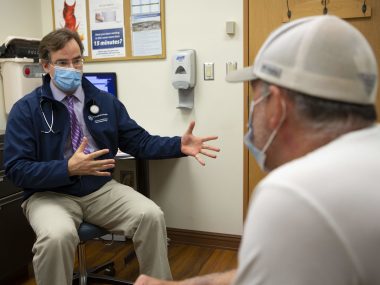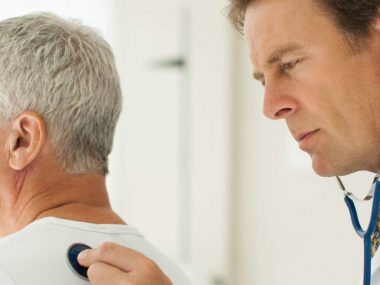Problems with sexual functioning are derived from myriad combinations of factors affecting the mind and body. Psychological variables may be related to anxiety, depression, stress, low self-confidence, and concerns regarding sexual performance or body image. Poor relationship quality and communication, as well as adverse partner characteristics, can also impact sexual function. Physical contributors include anatomy malformations, injury or illness, current medication use, and age.
Who Is Affected by Sexual Dysfunction?
Sexual problems can occur throughout the lifespan and affect people of any age. Although some sexual dysfunction is viewed as normative for younger adults, they may experience the same conditions as older adults, including premature ejaculation, lack of pleasure or orgasm, erectile difficulties, and pain.2
As a person ages, a decline in sexual response and activity is expected, particularly as women approach menopause which can affect later life sexuality. Men may experience changes in testosterone and bodily functioning, even though no comparable midlife changes exist. The strengths and characteristics of the partnered relationship can influence how well a couple adjusts their sexual activity to these physiological changes.2
Those with a chronic illness or disability can also be affected by sexual dysfunction, although there is great variability on how their sexuality is impacted depending on the condition. Sexual dysfunction can also affect sexual minority clients, including those in same-sex relationships, open relationships, and transgender individuals.
Sexual Disorders
When a sexual dysfunction develops into a problem, it may become a sexual disorder. The Diagnostic and Statistical Manual – (DSM)3 is the official handbook that clinicians use to determine an appropriate diagnosis. A compilation of sexual disorders is listed below, organized by desire and arousal disorders, orgasm disorders, and pain disorders.
These disorders are written in the DSM from a binary perspective about “men” and “women” and will be described as such for consistency. It is important to note, however, that these heteronormative and binary terms may not accurately represent how an individual self-identifies.
Terms
Some important terms to note when discussing sexual disorders include:
- Acquired: The disorder started at some point throughout one’s life. It is not a lifelong condition.
- Lifelong: The disorder has always been present.
- Situational: The problem occurs in specific contexts, such as only with a specific partner, or during partnered intercourse but not during solo masturbation.
- Generalized: The problem occurs in all situations.
Desire and Arousal Disorders
Desire and arousal disorders include Female Sexual Interest/Arousal Disorder, Male Hypoactive Sexual Desire Disorder, and Erectile Dysfunction.
Female Sexual Interest/Arousal Disorder (FSIAD)
Individuals affected by FSIAD experience a lack of interest in or aversion to sexual activities and fantasies, reduced arousal or sensation during sexual encounters, or some combination thereof.3 These symptoms must be present for a minimum of 6 months and occur in at least 75% of sexual encounters. FSIAD can be lifelong or acquired, generalized or situational, and has a mild, moderate, or severe specifier for diagnosis.
Causes
Many factors can contribute to SIAD.4 Menopause, mood disorders, and medication can impact hormones and sexual arousal or desire. Lack of intimacy or trust in the relationship can create sexual barriers, and negative sociocultural messages about sexual desire, masturbation, or sexual response can also have an adverse impact.
Treatment
SIAD treatment typically includes a mixture of pharmacological and psychological interventions, including but not limited to, hormone treatment, cognitive behavioral therapy (CBT),4 and mindfulness-based interventions. The therapist should also explore any psychosocial factors that may be contributing to SIAD.
Further Information
In the current edition of the DSM, SIAD is a condition that merges two previously identified sexual disorders. The first is female sexual arousal disorder (FSAD), a condition in which a woman finds it difficult to attain or maintain adequate lubrication from sexual excitement. The second is hypoactive sexual desire disorder (HSDD), which is low or absent sexual desire. SIAD replaces both of these conditions because of common overlap between the two disorders in presentation.4
Male Hypoactive Sexual Desire Disorder
This condition is otherwise known as low sexual desire in men. To meet criteria for a diagnosis, the symptoms must be present for a minimum of 6 months and he must find the symptoms distressing. Male HSDD can be lifelong or acquired, generalized or situational, and has a mild, moderate, or severe specifier for diagnosis.3
Risk Factors
for the development of sexual desire problems can include problems in the relationship, sociocultural messages about masculinity, early negative messages about sex, and biomedical factors such as age, hormone production, illness, and side effects from medication.5
Treatment
Replacement therapy can assist those with low testosterone,6 and medications may be prescribed or current medications adjusted. CBT can help an individual develop emotion regulation skills, challenge unhelpful thoughts, engage in stimulus control or sensate focus, and take steps to improve the relationship.5
Erectile Dysfunction (ED)
Men with ED have difficulty obtaining or maintaining an erection until completing sexual activity. They may also experience decreased rigidity.3 The problem must persist for at least 6 months and cause significant distress to the affected person. ED can be lifelong or acquired, generalized or situational, and has a mild, moderate, severe specifier for diagnosis.
Causes
There can be a variety of factors impacting ED, and the therapist will need to ask thorough questions to determine etiology. Common contributors to ED are vascular comorbidities, medication, performance anxiety, negative thoughts, and relationship issues.7
Treatment
Pharmacology may be one of the most well-known treatment methods for erectile dysfunction. Psychological treatment approaches include the use of CBT to decrease negative thought patterns and reduce performance anxiety.8 Other behavioral interventions such as sensate focus and sexual stimulation techniques have been used.7 A physical examination by a physician or urologist to rule out physiological problems might also be recommended.
Orgasm Disorders
Orgasm disorders include Female Orgasmic Disorder, Premature Ejaculation, and Delayed Ejaculation.
Female Orgasmic Disorder (FOD)
Those with FOD may experience difficulty or delay of orgasm or feel less intense sensations during orgasm. FOD can be lifelong or acquired, generalized or situational, and includes a specification for women who have never experienced orgasm at all.3 These symptoms must be present in at least 75% of sexual encounters to account for common variation in orgasmic activity.
Causes
FOD can be caused by individual variables, such as levels of anxiety, stress, or fatigue. Relationship factors, like the quality of partner interaction and communication, can impact a woman’s ability to orgasm. In some cases, physical illness, neurological or gynecological issues, diabetes, spinal cord injury and medication can create problems associated with FOD.9
Risk Factors
Poor physical and mental health has been associated with FOD, as well as problems within the partnered relationship. FOD has a high comorbidity rate with other sexual concerns regarding arousal, sexual desire, and lack of vaginal lubrication.9
Treatment
Individuals with FOD practice stimulation techniques, sensate focus, and learn psychological CBT interventions that decrease performance anxiety and encourage erotic fantasy.9,10 Other treatments include medication or hormone treatment.9
Premature Ejaculation (PE)
Individuals affected by PE ejaculate with minimum stimulation during intercourse, typically within 1 minute of penetration. The problem must last a minimum of 6 months and occur in at least 75% of sexual encounters. It can be lifelong or acquired, generalized or situational, and includes mild, moderate, and severe specifiers.3
Causes
PE can be due to medical conditions, such as neurological disorders, urological problems, or physical injury.11 Psychological factors include performance anxiety, stress, poor confidence or body image, and negative early learned experiences.11
Treatment
Pharmacological treatments include topical creams or medication such as SSRIs.12 Penile exercises, CBT, and individual or conjoint therapy are other treatment options.8,12
Delayed Ejaculation (DE)
Men with DE find it difficult or impossible to orgasm and ejaculate,3 even with sufficient stimulation, erection, and a desire to orgasm, leading to marked distress. DE is one of the least common and understood sexual disorders,13 and is also known as male orgasmic disorder, delayed orgasm, and inhibited/impaired ejaculation.
Causes
During the assessment, the therapist will complete a thorough history of the problem’s progression, noting factors that improve or aggravate symptoms. There is still a lot to learn about what causes DE, although it is believed to be impacted by individual, biological, psychological, and relationship factors. Specifically, unique masturbation habits and age can be influencers.13
Treatment
Treatment often includes an integration of medication, psychotherapy, and behavioral masturbatory retraining.13 The clinician should also assess for and address any performance anxiety and self-criticism.
Pain Disorders
Pain disorders include Dyspareunia and Vaginismus. These disorders present similarly, but while Vaginismus is solely a female disorder, both males and females may experience Dyspareunia.
Dyspareunia
Those with dyspareunia experience significant genital pain during intercourse, and also with insertion of tampons, fingers, or during gynecological examinations.14 Both males and females can be affected by dyspareunia, although more attention has been given to dyspareunia in females.
Causes
Physiological factors, including nerve damage or dysfunction, extreme sensitivity, damage from surgeries (i.e. episiotomies), and more rarely, vaginal or genital malformations can all contribute to genital pain.14,15 Psychologically, pain may be exacerbated by anxiety, catastrophizing, negative thoughts or expectations, or lack of attraction to partner.9,14
Treatment
Less invasive strategies are used first in treatment and include medication, topical lidocaine, CBT for pain management, and therapy to improve sexual functioning within the partnered relationship. More physical treatments of pelvic floor therapy and manual or insertion exercises may be recommended. More invasive treatments, such as surgery, depend on the nature of the pain in the genitals and what direction of treatment the person wishes to take.14
Vaginismus
Similar to dyspareunia, those with vaginismus have difficulty with vaginal penetration due to genital pain. The musculature surrounding the vaginal opening is subject to spasms and hypertonicity, making sexual intercourse virtually impossible. Women feel burning, stretching, or tearing sensations around the vaginal opening, and often experience an extreme level of fear regarding penetration.15,16
Causes
Much more research needs to be done on vaginismus before we find a specific cause. Conservative perspectives, history of sexual abuse, lack of sex education, and issues in the relationship have been identified as causal variables for vaginismus, but none have been verified through empirical research.17
Treatment
Many treatments used with dyspareunia are helpful with treating vaginismus. Less invasive treatments are explored first, including medication, topical creams, decreasing negative thoughts, addressing the cycle of fear-avoidance, and improving the partnered relationship.
More intense treatments may be required, such as pelvic floor therapy or surgery.16 Undergoing a medical examination by a physician or gynecologist may be one of the first interventions for addressing vaginismus.8
Further Information
In the DSM, dyspareunia and vaginismus are merged under genito-pelvic pain/penetration disorder.3 The merge was a response to difficulty with differentiating dyspareunia and vaginismus, which may be attributed to a lack of research and the fact that there is much to be learned about both conditions.
Other Sexual Disorders
Other sexual disorders include Paraphiliac Disorders, Persistent Genital Arousal Disorder, and Hypersexuality Disorder.
Paraphiliac Disorders
Paraphilias are unusual sexual interests, such as voyeurism, exhibitionism, pedophilia, fetishism, and sexual sadism and masochism.18 The lines between sexual deviance and psychopathology are complicated by the fact that there is no scientific answer to what is considered “normal” sexual behavior. Many people who seek help for a paraphilia are referred for treatment after a criminal sexual offense.18
Causes
Due to a lack of research and possible underreporting out of fear of marginalization, what we know about paraphilias is limited. What has been considered sexually deviant has evolved throughout history, and the question of whether paraphilias should be considered a disorder at all remains controversial.
Treatment
Not all individuals view their sexual interests to be problematic, and treatment for paraphilias is implemented only when there is significant distress or dysfunction. Treatment for sex offenders and those whose paraphilias are of a public concern (i.e. pedophilia) include pharmacological, psychological, and community support interventions, although controversy exists regarding whether these treatments are effective.18
Persistent Genital Arousal Disorder (PGAD)
Those with PGAD feel unwanted and highly distressing genital arousal sensations that do not subside even after multiple orgasms.19 Women report feelings of imminent orgasm or genital contractions and some experience vaginal or clitoral pain or pain with penetration. Triggers can vary from psychological stress and anxiety to wearing tight clothing or sitting.
While PGAD is not classified as a sexual disorder, it is a harmful condition to sexuality. It can appear similar to hypersexuality because repeated masturbation is seen in both conditions. However, the motivation for masturbation in PGAD is due to unwanted arousal, which sets it apart from hypersexuality.19
Treatment
Treatment often begins with a genital or pelvic examination by a physician or gynecologist. Medication and pelvic floor physical therapy may be recommended, as well as an assessment of any comorbid issues. Psychological approaches from mindfulness-based CBT can help women observe their PGAD symptoms rather than focus on the negative thoughts. Treatment primarily focuses on symptom management and enhancing sexual pleasure, rather than on finding a cure.19
Hypersexuality Disorder
You may more commonly recognize this disorder as sexual addiction. Those with hypersexuality disorder experience disinhibited frequent and repetitive sexual urges, fantasies, and behaviors.20
Causes
The cause is unknown.20 Hypersexuality disorder may be comorbid with mood disorders such as anxiety, depression, ADHD, or with other sexual disorders. Hypersexuality, in the context of other episodic symptoms of mania, is a hallmark symptom of bipolar disorder.
Treatment
Medication and psychological treatment such as individual or conjoint therapy, group therapy, CBT, and behavioral therapy have been used.20
Who Can Treat Sexual Dysfunction?
Sex therapists or sexologists are mental health professionals with specific training in the field of sexual health and therapy. In many cases, it is appropriate for the sex therapist to collaborate closely with medical providers such as urologists or gynecologists to ensure a comprehensive and integrated approach to treatment.
What to Expect at Your First Therapy Appointment
Once a problem has been identified, you may seek help from a sex therapist. Their job is to assess the problem and situation, and work with you, and your partner if applicable, on a treatment regimen. Sex can be a difficult topic to talk about, especially with someone you just met, and your therapist will be sensitive to this. One of their first objectives is to build a trusting rapport with you and your partner so that a respectful and comfortable therapeutic setting can be established.
Your therapist will conduct an initial interview to get to know you and understand your concerns. This assessment consists of multiple components, including details about the problem, medical history, psychological or physiological comorbidities, features of the family of origin, psychosocial and sociocultural factors, and limitations and strengths regarding treatment.9
Information about your sexual history will also be gathered.9 The therapist may ask about areas regarding partnered and unpartnered sexual activity, past sexual experiences, negative sexual messages, orgasmic capacity, pain issues, and sexual satisfaction.
Other helpful information may be related to patterns of avoidance and anxiety, gender identity, sexual orientation, history of sexual trauma, conflict in the couple relationship, attraction to partner, and availability of privacy in the home. Before or after the first session, you may be referred to a physician or specialist for diagnostic testing or a physical examination.
Treatment Options
Treatment for sexual disorders generally fall within pharmacological, psychological, medical, or psychoeducational categories, with many treatment approaches using a combination of the aforementioned therapies. Therapists must ultimately tailor treatment to the individual or couple, the specific problems they bring to therapy, and the treatment direction they wish to pursue.
Pharmacological
Pharmacological interventions may include medication (or a change in current medications), hormone replacement therapy, or topical creams or ointments, or a combination of these treatments.
Medication
Many sexual disorders can be treated with pharmacological interventions aimed at improving sexual functioning. For example, medications which improve blood flow to the penis are well known for treatment of erectile dysfunction, and SSRIs have been used for premature ejaculation.
It is also important for the therapist to attain an accurate picture of current medication use, as sometimes this may be a contributor to the problem and it can be fixed or helped with medication adjustment.
Hormone Replacement Therapy
Hormone replacement therapy has been used to treat certain conditions, such as female SIAD and male HSDD, along with concurrent medication use.
Topical Creams or Ointments
Creams or ointments such as lidocaine are used to desensitize genital tissue regarding problems associated with premature ejaculation and pain disorders.
Psychological
Psychological interventions for sexual disorders frequently include sex therapy, but may involve specific forms of psychotherapy, such as behavioral therapy, CBT, or psychoeducation.
Sex Therapy and Psychotherapy
A qualified clinician can provide psychological tools and strategies for management of distress related to the sexual problem. Psychotherapy can help an individual address interfering factors to sexual functioning, including feelings of fear, anxiety, guilt, shame, or avoidance.
Perceptions of poor body image or trauma related to sexual abuse are other areas that can adversely affect sexual functioning and may be addressed in therapy. Conjoint therapy addresses both relationship issues and aims to improve satisfaction during sexual encounters.
Behavioral Therapy
This includes a variety of techniques and exercises for treatment aimed to increase sexual satisfaction and function. Behavioral treatments can include penile exercises, sexual stimulation techniques, and sensate focus. Medical devices can also aid in therapy. Penile vacuums and implants are used to enhance erectile ability, while vacuums and dilators can assist with stretching the vagina.
Cognitive Behavioral Therapy (CBT)
CBT is an approach to therapy which assumes that our thoughts, beliefs, and perceptions influence our feelings about an activating event. Many CBT-based approaches for treatment in sexual disorders focus on mindfulness, neutralizing negative thoughts, decreasing performance anxiety, and restructuring negative thought distortions.
Psychoeducation
Psychoeducation includes both general education and bibliotherapy:
- Education: Learning about sexual anatomy, behaviors, and responses can empower individuals and help reduce anxiety.
- Bibliotherapy: Your therapist may recommend reading material or workbooks in order to learn more about your body, the sexual disorder and related concerns, relationship enhancement, and other relevant topics.
Medical Examinations & Therapy
If you are dealing with a sexual disorder, getting a physical examination will be a likely part of the treatment process. It is important to be sure no other physiological issues are part of what is causing the issue.
Physical Examination
It is not uncommon for your therapist to request an examination to be done by a physician, urologist, or gynecologist. The intent of these exams may include a need to assess anatomy, rule out medical or biological issues that might interfere with treatment, or to provide additional information to the therapist about what factors are contributing to or maintaining the problem.
Pelvic Floor Therapy
Pelvic floor therapy addresses weakness, pain, and other dysfunction in the pelvic floor musculature.
Treatment Considerations for Sexual Minority Clients
Talking with anyone about your sexual disorder requires openness and trust. Individuals of sexual minority may feel especially vulnerable, as they are subject to discrimination, marginalization, and heteronormativity when addressing sexual concerns. Heteronormativity is the belief that opposite sex partnership and penis-vagina intercourse is the normative standard.8
The therapist must be diligent to minimize marginalization from heteronormative standards during session and create an environment where the client can accept themselves and their sexuality. The therapist will attend to the intersecting identities of age, race, religion, education level, socio-economic status, gender orientation, sexual orientation, and relationship orientation, as well as how internalized oppression, discrimination, or violence has impacted the client.
Summary
Sexual dysfunction is a relatively common, yet often hidden problem for many individuals. Sexuality is a significant part of our livelihoods and with support from medical and mental health professionals, many people learn how to effectively manage, treat, or reverse the difficulties they experience.






